|
H.W. Stockman (hwstock at alum dot mit dot edu)
Sunday May 2, 2004 |
The hike was ably led by Joel Brewster, who was
respectfully followed by Bill, Burgess, Ali and Harlan. Net elevation
gain was 2900', but all the ups-and-downs amounted to more than 3700',
and the total distance was ~8.35 miles. We were surprised to find
towers on top (perhaps built by aliens), so we suspect this was not a
first ascent. The top of Potosi is over 8500', and we came across a bit
of snow on the north-facing slopes.
We saw one hang glider riding thermals, leading us to discuss the incredible accuracy of the TV show CSI (search for "Potosi" on that web page).
Click on any small image to see a larger picture. (Cliquez
sur une petite image pour voir la grande image correspondante.) Order
is essentially chronological. Even the large images are reduced in size
to 20% the number of pixels in the originals, or smaller. Contact me if
you want the full-sized images. To save a large image under Windows, 1)
click on the corresponding small image; 2) when the large image appears
(fully), right-click on the image and choose "Save Picture As..." on
the menu. Be sure to note where you saved the image!
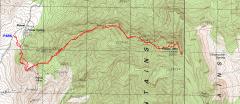
GPS trace on map. |
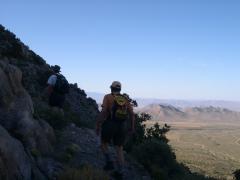
Early on, view S, before the sun hits us. |
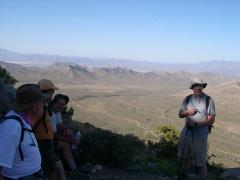
View SW, 1st break. |
|
|
|
|
|
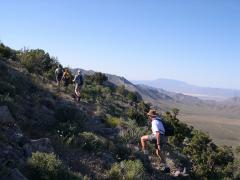
1st Sun! Kingston Mt CA in distance. |

Heading E. |
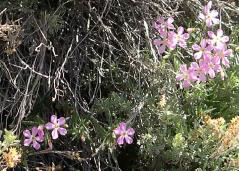
Pink Phlox. |
|
|
|
|
|

Blue Flax. |
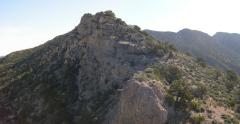
Looking E -- the intrepid explorers are visible on the far right side of photo. |

View back SW, toward Kingston Peak. |
|
|
|
|
|
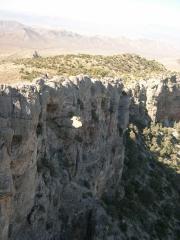
There is a human in this photo; also the sun patch from a rock arch. |
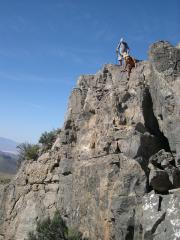
View W, descending one tight spot. |
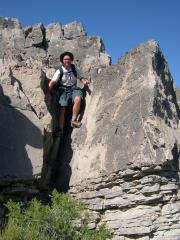
Picture for Amy. |
|
|
|
|
|
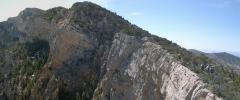
View SE. Humans at right side of picture. Snow at left. |
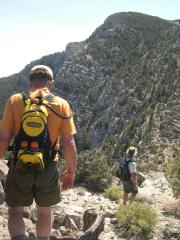
|

Descending E past alien structure. |
|
|
|
|
|

View NNE of Red Rock and La Madre |

View SE of lower Potosi Peak and alien towers. |
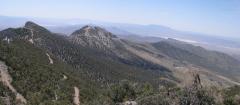
View SE from top. |
|
|
|
|
|

On Top. Cerebellum check for Harlan. Would you
believe he injured his R hamstring the day before? Ah, the therapeutic
wonders of hiking. |

On Top. View SW. |
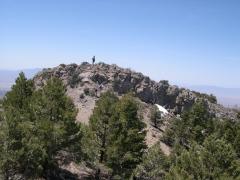
Descent, view W. |
|
|
|
|
|
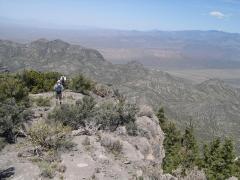
More descent; looking NNW toward 7200' Mt Rufkahr (on L) and snow-covered Charleston Peak (at R). |

Collared lizard, typical coloration. His body was ~5" long, the tail was another 9" or so. |
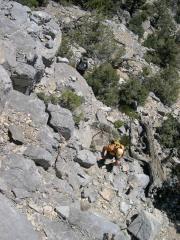
Preparing to climb up a ridge. |
|
|
|
|
|
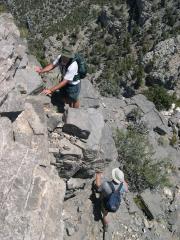
|

Oops! An out-of-sequence picture. View N from the top. Charleston Peak at center. The back side of Red Rock is to the right. |
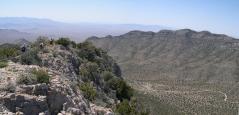
More descent. |
|
|
|
|
|
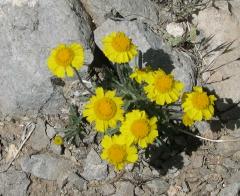
|
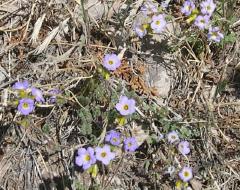
Fremont phacelia (thanks to Anya D for the ID). |

We went over this lump on way up, to left of it on way down. |
|
|
|
|
Where did the name "Potosi"
originate? Well, there is a Bolivian Indian word Potosí (Hispanicized;
note the accent on the last syllable) meaning "place of much noise."
Potosí is a rich lead-silver mining district in Bolivia, and
lead-silver mining districts all over (for example, one in Missouri)
were named Potosí, perhaps in hopes that they would share in the
economic good times of their namesake.
Much of the lead ore in this area is oxidized, now as white cerrusite (PbCO3) and anglesite (PbSO4). If you've ever visited the Stanley B. Springs mines near Mt. Charleston, you have probably seen similar ore.





























